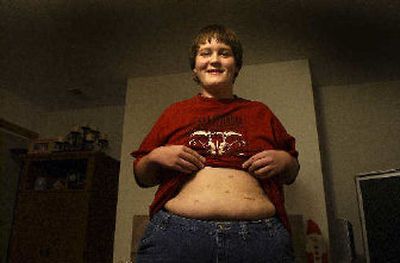Losing pounds a weighty family affair

All day Friday, 15-year-old Bob Plumb lumbered through the halls of Central Valley High School with 47 pounds of canned goods hanging from his back.
With every turn there came an apology. Barely able to fit through the lunch line, his backpack knocked into teenage girls left and right.
But Plumb just smiled. It wasn’t long ago that the 47 pounds he was carrying for the school’s food drive was actually his own girth.
Six weeks ago, Plumb weighed 363 pounds. After a drastic and controversial weight loss surgery called banding, he’s down to almost 300 and still losing. He doesn’t even mind wearing a joke T-shirt that reads, “I beat anorexia.”
“I can actually walk up the stairs at school without wheezing,” Plumb said.
Plumb has never been able to ride a bicycle. Obesity became a problem when the Spokane Valley teen was a toddler and his balance was too unstable.
His weight also prohibited him from learning to skateboard, snowboard, rock climb, and riding a roller coaster.
But after years of being bullied, laughed at and left out, the soft-spoken teen may have a chance at a normal life.
The boy’s surgery coincided with the decision of his parents, Liz and Scott, to have the procedure in May 2004. Liz Plumb was so obese she took numerous medications, including high-blood pressure pills, and couldn’t walk without a cane.
Liz and Scott Plumb have each lost more than 100 pounds.
Though Bob is young, his parents say the decision to allow their son to undergo the surgery was an easy one for them.
“His genes are against him,” said Liz, who acknowledges her son’s eating habits have also led to his obesity. “To make him wait until he was older, we thought it was just mean.”
Similar to gastric bypass surgery but less invasive, banding involves placing an adjustable band around the upper part of the stomach to reduce its capacity. The stomach area is accessed laproscopically through four to six small incisions.
The band is a silicone ring that can be adjusted to control the size of the small gastric pouch, which controls the amount of food a person can eat and slows the digestion process.
Unlike gastric bypass, banding patients can eat whatever they want, but in drastically smaller portions.
“We call it a prosthetic full button,” said Plumb’s mother. “You eat until you are full.”
The Plumbs have six children, some from previous marriages. None except Bob has had problems with obesity.
By the time the youngest child, Mariah, 11, was born, Liz said she had learned from her mistakes: “I learned I was equating food with love. I had to change my parenting.”
But for Bob, it was too late. His regular diet consisted of greasy fast food, soda, candy and chips.
Food would go missing, and nobody would fess up.
His family moved to Spokane Valley from Las Vegas in June, and though Bob said the students are friendlier here, he still struggled to keep up with his peers.
Last summer, he stood in a long line for a ride at Silverwood Theme Park, only to be told he was “too fat” to get on. When he was younger, Plumb twice tried to play football, but when he fell, the weight of his body broke his wrist.
“I was risking my life, and I knew I had to change,” he said.
Though some American physicians advise against going out of the country, the Plumb family traveled to Mexico for their surgeries. It cost about $8,000 compared to $20,000 in the United States.
“I figured if we got down there, and there were chickens in the waiting room, we’d just come home,” Liz Plumb said.
She also said they would never have considered gastric bypass, where the stomach is surgically altered. The banding is reversible.
Statistically, gastric bypass has a higher mortality rate than banding, said Georgann Mallory with the American Society for Bariatric Surgery. About 170,000 people a year have weight-loss surgery in the United States.
“In the hands of an experienced surgeon, the mortality is around 0.5 percent. But in some studies, it’s about 2 percent,” Mallory said. For banding, it’s about 0.1 percent.
Spokane surgeon Matt Rawlins disagrees.
“I think that’s just bogus. I think there are a lot of complications with them,” said Rawlins, who performs gastric bypass surgeries. “One of the most scary risks is that it can erode through to the stomach. It is very difficult to reconstruct a stomach.”
Rawlins does not perform adjustable band surgeries.
Patients who have banding tend to lose about half as much of their excess weight in the first year as those who have gastric bypass. It also has less of an impact on medical problems that go along with obesity, like diabetes, he said.
But the Plumbs have had very few complications from the surgery.
“We’re different people now,” Scott said.
They say the only problem they’ve experienced is finding doctors in the United States who will make adjustments to the band. Only a few doctors, including the one the Plumbs see in Portland, will make alterations to a band installed in Mexico, for liability reasons.
Bob has needed one adjustment so far, and has lost 6 inches around his waist and dropped four pant sizes, from 54 to 50. His goal is to weigh between 210 and 220 pounds.
He gives his cookies away to friends, and eats half a chef’s salad at lunch every day.
When he isn’t singing bass in the high school jazz and a cappella choirs, he plans to try his hand at the shot put in track and maybe have a crack at football again. He’ll definitely try to ride a bike.
“And yesterday I got my first compliment from a girl,” Plumb said. “That was pretty cool.”